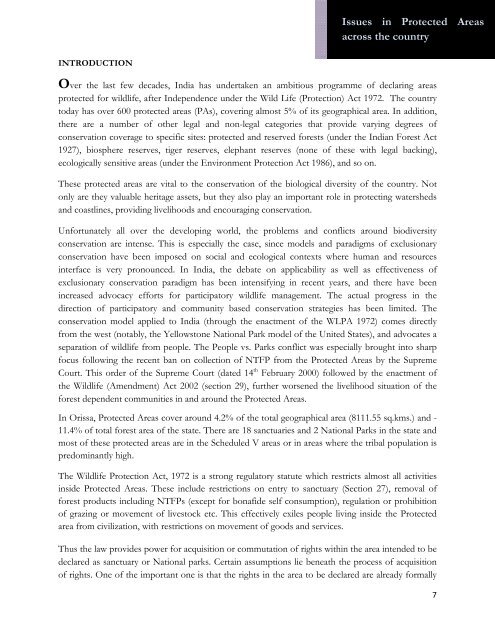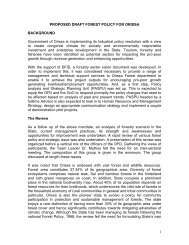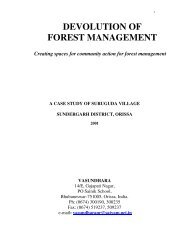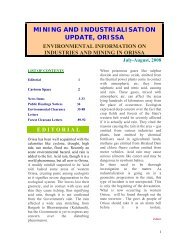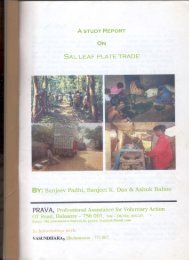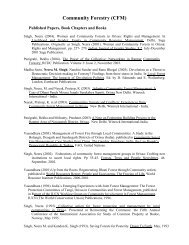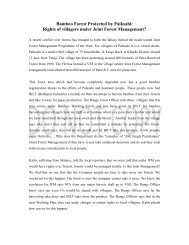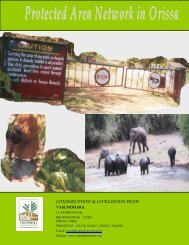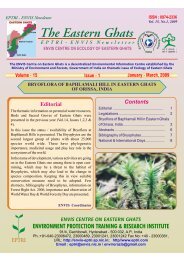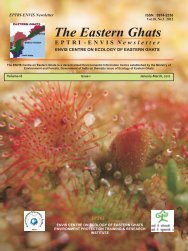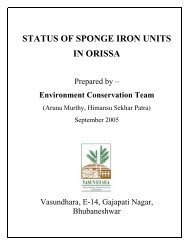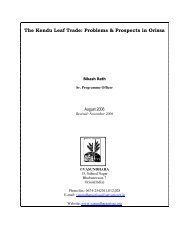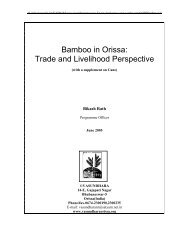Impact of NTFP ban on the lives and livelihood of the ... - Vasundhara
Impact of NTFP ban on the lives and livelihood of the ... - Vasundhara
Impact of NTFP ban on the lives and livelihood of the ... - Vasundhara
You also want an ePaper? Increase the reach of your titles
YUMPU automatically turns print PDFs into web optimized ePapers that Google loves.
Issues in Protected Areasacross <strong>the</strong> countryINTRODUCTIONOver <strong>the</strong> last few decades, India has undertaken an ambitious programme <str<strong>on</strong>g>of</str<strong>on</strong>g> declaring areasprotected for wildlife, after Independence under <strong>the</strong> Wild Life (Protecti<strong>on</strong>) Act 1972. The countrytoday has over 600 protected areas (PAs), covering almost 5% <str<strong>on</strong>g>of</str<strong>on</strong>g> its geographical area. In additi<strong>on</strong>,<strong>the</strong>re are a number <str<strong>on</strong>g>of</str<strong>on</strong>g> o<strong>the</strong>r legal <strong>and</strong> n<strong>on</strong>-legal categories that provide varying degrees <str<strong>on</strong>g>of</str<strong>on</strong>g>c<strong>on</strong>servati<strong>on</strong> coverage to specific sites: protected <strong>and</strong> reserved forests (under <strong>the</strong> Indian Forest Act1927), biosphere reserves, tiger reserves, elephant reserves (n<strong>on</strong>e <str<strong>on</strong>g>of</str<strong>on</strong>g> <strong>the</strong>se with legal backing),ecologically sensitive areas (under <strong>the</strong> Envir<strong>on</strong>ment Protecti<strong>on</strong> Act 1986), <strong>and</strong> so <strong>on</strong>.These protected areas are vital to <strong>the</strong> c<strong>on</strong>servati<strong>on</strong> <str<strong>on</strong>g>of</str<strong>on</strong>g> <strong>the</strong> biological diversity <str<strong>on</strong>g>of</str<strong>on</strong>g> <strong>the</strong> country. Not<strong>on</strong>ly are <strong>the</strong>y valuable heritage assets, but <strong>the</strong>y also play an important role in protecting watersheds<strong>and</strong> coastlines, providing <strong>livelihood</strong>s <strong>and</strong> encouraging c<strong>on</strong>servati<strong>on</strong>.Unfortunately all over <strong>the</strong> developing world, <strong>the</strong> problems <strong>and</strong> c<strong>on</strong>flicts around biodiversityc<strong>on</strong>servati<strong>on</strong> are intense. This is especially <strong>the</strong> case, since models <strong>and</strong> paradigms <str<strong>on</strong>g>of</str<strong>on</strong>g> exclusi<strong>on</strong>aryc<strong>on</strong>servati<strong>on</strong> have been imposed <strong>on</strong> social <strong>and</strong> ecological c<strong>on</strong>texts where human <strong>and</strong> resourcesinterface is very pr<strong>on</strong>ounced. In India, <strong>the</strong> debate <strong>on</strong> applicability as well as effectiveness <str<strong>on</strong>g>of</str<strong>on</strong>g>exclusi<strong>on</strong>ary c<strong>on</strong>servati<strong>on</strong> paradigm has been intensifying in recent years, <strong>and</strong> <strong>the</strong>re have beenincreased advocacy efforts for participatory wildlife management. The actual progress in <strong>the</strong>directi<strong>on</strong> <str<strong>on</strong>g>of</str<strong>on</strong>g> participatory <strong>and</strong> community based c<strong>on</strong>servati<strong>on</strong> strategies has been limited. Thec<strong>on</strong>servati<strong>on</strong> model applied to India (through <strong>the</strong> enactment <str<strong>on</strong>g>of</str<strong>on</strong>g> <strong>the</strong> WLPA 1972) comes directlyfrom <strong>the</strong> west (notably, <strong>the</strong> Yellowst<strong>on</strong>e Nati<strong>on</strong>al Park model <str<strong>on</strong>g>of</str<strong>on</strong>g> <strong>the</strong> United States), <strong>and</strong> advocates aseparati<strong>on</strong> <str<strong>on</strong>g>of</str<strong>on</strong>g> wildlife from people. The People vs. Parks c<strong>on</strong>flict was especially brought into sharpfocus following <strong>the</strong> recent <str<strong>on</strong>g>ban</str<strong>on</strong>g> <strong>on</strong> collecti<strong>on</strong> <str<strong>on</strong>g>of</str<strong>on</strong>g> <str<strong>on</strong>g>NTFP</str<strong>on</strong>g> from <strong>the</strong> Protected Areas by <strong>the</strong> SupremeCourt. This order <str<strong>on</strong>g>of</str<strong>on</strong>g> <strong>the</strong> Supreme Court (dated 14 th February 2000) followed by <strong>the</strong> enactment <str<strong>on</strong>g>of</str<strong>on</strong>g><strong>the</strong> Wildlife (Amendment) Act 2002 (secti<strong>on</strong> 29), fur<strong>the</strong>r worsened <strong>the</strong> <strong>livelihood</strong> situati<strong>on</strong> <str<strong>on</strong>g>of</str<strong>on</strong>g> <strong>the</strong>forest dependent communities in <strong>and</strong> around <strong>the</strong> Protected Areas.In Orissa, Protected Areas cover around 4.2% <str<strong>on</strong>g>of</str<strong>on</strong>g> <strong>the</strong> total geographical area (8111.55 sq.kms.) <strong>and</strong> -11.4% <str<strong>on</strong>g>of</str<strong>on</strong>g> total forest area <str<strong>on</strong>g>of</str<strong>on</strong>g> <strong>the</strong> state. There are 18 sanctuaries <strong>and</strong> 2 Nati<strong>on</strong>al Parks in <strong>the</strong> state <strong>and</strong>most <str<strong>on</strong>g>of</str<strong>on</strong>g> <strong>the</strong>se protected areas are in <strong>the</strong> Scheduled V areas or in areas where <strong>the</strong> tribal populati<strong>on</strong> ispredominantly high.The Wildlife Protecti<strong>on</strong> Act, 1972 is a str<strong>on</strong>g regulatory statute which restricts almost all activitiesinside Protected Areas. These include restricti<strong>on</strong>s <strong>on</strong> entry to sanctuary (Secti<strong>on</strong> 27), removal <str<strong>on</strong>g>of</str<strong>on</strong>g>forest products including <str<strong>on</strong>g>NTFP</str<strong>on</strong>g>s (except for b<strong>on</strong>afide self c<strong>on</strong>sumpti<strong>on</strong>), regulati<strong>on</strong> or prohibiti<strong>on</strong><str<strong>on</strong>g>of</str<strong>on</strong>g> grazing or movement <str<strong>on</strong>g>of</str<strong>on</strong>g> <strong>lives</strong>tock etc. This effectively exiles people living inside <strong>the</strong> Protectedarea from civilizati<strong>on</strong>, with restricti<strong>on</strong>s <strong>on</strong> movement <str<strong>on</strong>g>of</str<strong>on</strong>g> goods <strong>and</strong> services.Thus <strong>the</strong> law provides power for acquisiti<strong>on</strong> or commutati<strong>on</strong> <str<strong>on</strong>g>of</str<strong>on</strong>g> rights within <strong>the</strong> area intended to bedeclared as sanctuary or Nati<strong>on</strong>al parks. Certain assumpti<strong>on</strong>s lie beneath <strong>the</strong> process <str<strong>on</strong>g>of</str<strong>on</strong>g> acquisiti<strong>on</strong><str<strong>on</strong>g>of</str<strong>on</strong>g> rights. One <str<strong>on</strong>g>of</str<strong>on</strong>g> <strong>the</strong> important <strong>on</strong>e is that <strong>the</strong> rights in <strong>the</strong> area to be declared are already formally7


